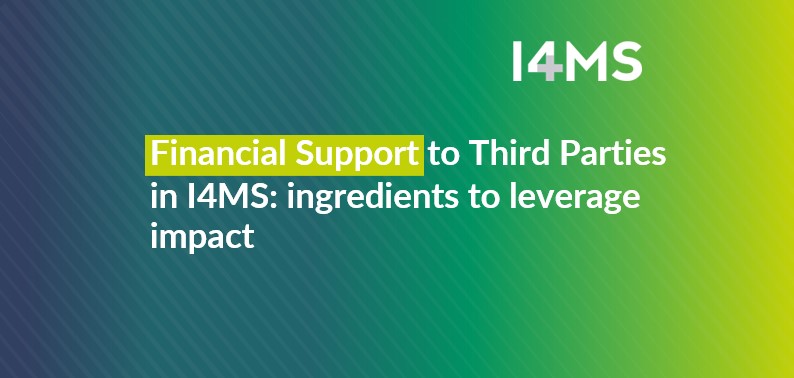Financial Support to Third Parties in I4MS: ingredients to leverage impact
I4MS has been delivering Financial support to Third Parties (FSTP) since 2013, with more than 600 experiments funded through 9 years, the project generated significant knowledge on the distribution of funds to manufacturing companies.
To identify successful practices, common trends and recommendations to leverage the impact of these funding mechanisms, Coordination and Support Action’s team conducted 19 interviews with the I4MS Innovation Actions coordinators, experts that have been working supporting SMEs in becoming digital and projects with experiences in delivering cascade funds.
FSTP has been recognised as a useful mechanism to support SMEs in the uptake of new technologies, it allows them to test how the different technologies could be applied in their business and the impact that could have on the company productivity, reduction of costs or energy efficiency.
Experts agree that during the preparation of the open call, the needs and challenges of the SMEs should be considered. Some projects such as Change2Twin and PULSATE are considering two different mechanisms for SMEs, one, to firstly understand the technology and assess what it can bring to them and second, to test this technology to improve a product, service or process. Additionally, it has been suggested that during the design of the open call applicants should be requested to fill-in a standardised KPIs, for the purpose of monitoring at later stages. The monitoring system would allow follow-up the digital maturity of the SMEs (at the beginning of Application Experiment and at the end and also at later stages).
When it comes to awareness raising and dissemination, all experts agree that the network of Digital Innovation Hubs built around each project has been a key channel to reach SMEs. The organisation of info sessions, creation of helpdesk and offering support to potential applicants during the application process is a common practice in projects delivering funds. Info sessions are as well an opportunity to spread the word about the open calls and advantages of adopting the technologies promoted by the projects.
In relation to the selection of Application Experiments, projects concur that, although external evaluation is a system that offers transparency and independency, projects need to add mechanisms to facilitate the selection of proposals that will better contribute to the objectives of the project. For example, the selection of SMEs that use different approaches to adopt a technology or, combining external and internal evaluations. No matter how the evaluation is done, strong efforts to select the best fitting experiments are required from the projects, either to train evaluators, organise pitching sessions or stages.
Concerning the mentoring and support to SMEs, projects are not only offering technical support, but also business mentoring, among others. Throughout the interview process, it became clear that mentors play a key role during the technology adoption process, therefore a vast network of mentors and evaluators in specific technology areas shall be of value for the I4MS projects as well as for the newly established European Digital Innovation Hubs.

As to the additional support to SMEs after the end of the support programme, experts see eye to eye that recommendations for future technology developments and clear technology adoption roadmaps would facilitate the continuation of the experiments by the beneficiary SMEs. Making SMEs prone to invest in technology adoption requires a better understanding of the value and potential return on investment related to the use of the technology.
Additional funding has been also seen as a barrier for technology adoption; however, projects should also explore the connection of their SMEs with potential customers or networks to broaden their reach. EDIHs could have a role in connecting SMEs with other innovation ecosystems such as projects supporting AI adoption, EDIHs outside their country and SMEs having gone through similar pathways to foster peer-learning. Additionally, DIHs or now EDIHs having supported SMEs during Application Experiments could guide them through the next technology adoption phase.
A full report gathering the insights and experiences of the different projects will be presented in November 2022.
In the meanwhile you can read more about related news related to the manufacturing community here.


